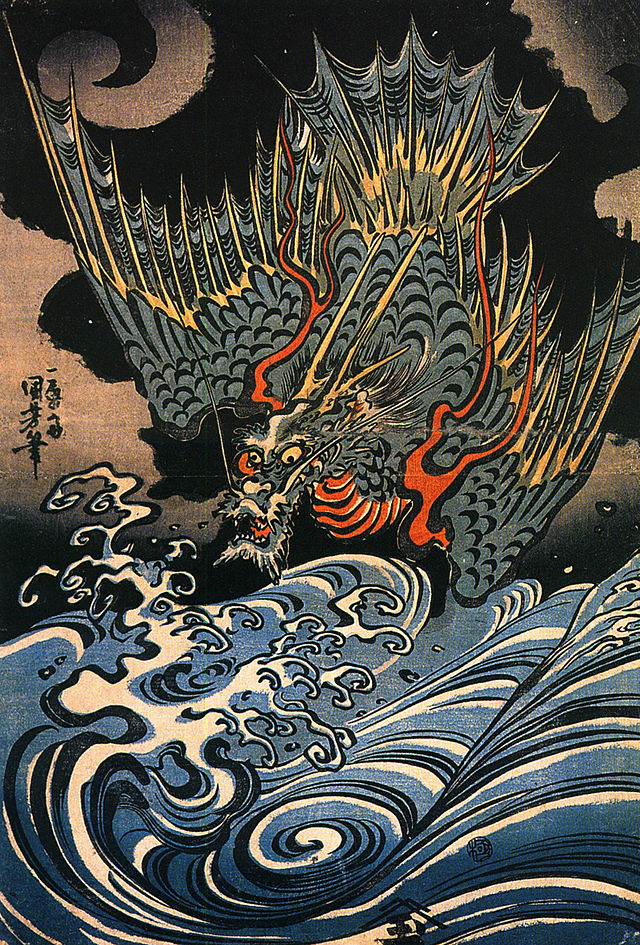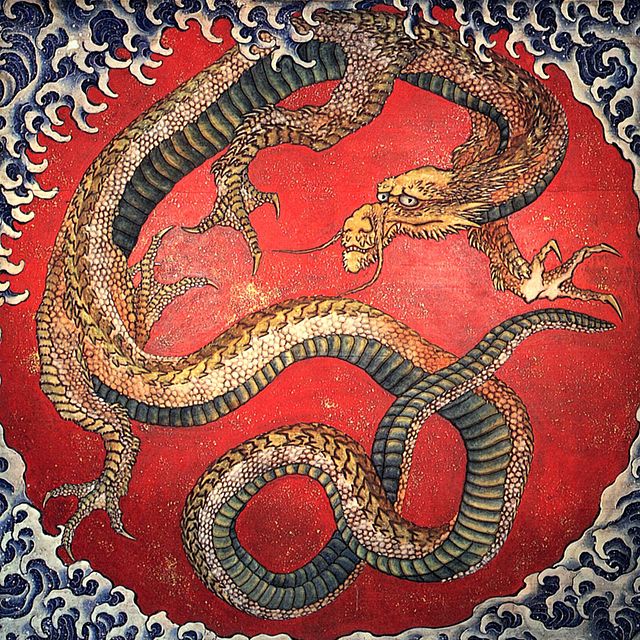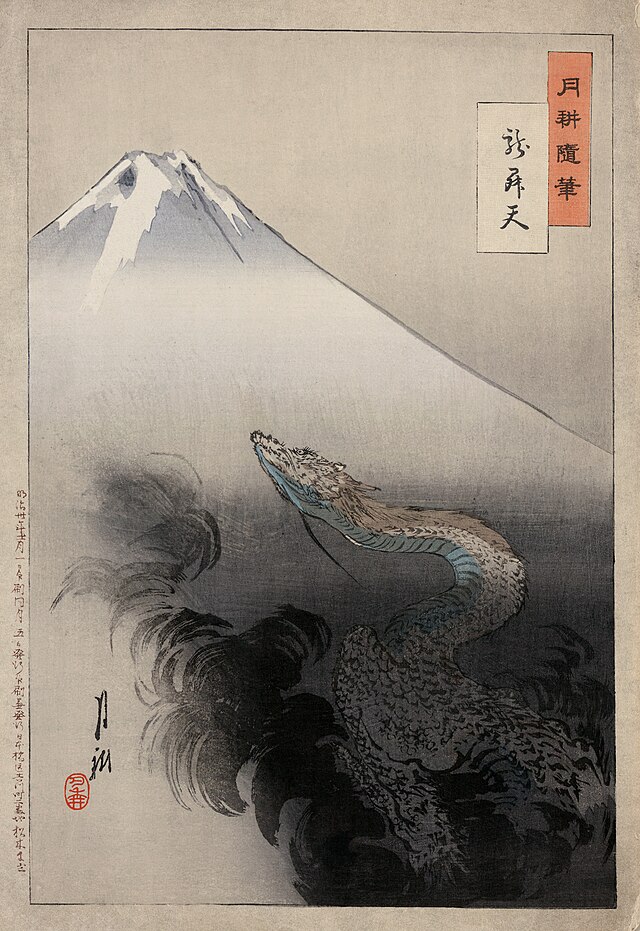Japanese dragon
Serpentine creature in Japanese mythology From Wikipedia, the free encyclopedia
Serpentine creature in Japanese mythology From Wikipedia, the free encyclopedia
Japanese dragons (日本の竜/龍, Nihon no ryū)[a] are diverse legendary creatures in Japanese mythology and folklore. Japanese dragon myths amalgamate native legends with imported stories about dragons from China, Korea and the Indian subcontinent. The style and appearance of the dragon was heavily influenced by the Chinese dragon, especially the three-clawed long (龍) dragons which were introduced in Japan from China in ancient times.[1]: 94 Like these other East Asian dragons, most Japanese ones are water deities or kami[2] associated with rainfall and bodies of water, and are typically depicted as large, wingless, serpentine creatures with clawed feet.







The c. 680 AD Kojiki and the c. 720 AD Nihongi mytho-histories have the first Japanese textual references to dragons. "In the oldest annals the dragons are mentioned in various ways," explains de Visser,[3] "but mostly as water-gods, serpent- or dragon-shaped." The Kojiki and Nihongi mention several ancient dragons:
Chinese dragon mythology appears to be the source of Japanese dragon mythology. Japanese words for "dragon" are written with kanji ("Chinese characters"), either simplified shinjitai 竜 or traditional kyūjitai 龍 from Chinese long 龍. These kanji can be read tatsu in native Japanese kun'yomi,[b] and ryū or ryō in Sino-Japanese on'yomi.[c]
Many Japanese dragon names are loanwords from Chinese. For instance, the Japanese counterparts of the astrological Four Symbols are:
Japanese Shiryū 四竜 "4 dragon [kings]" are the legendary Chinese Longwang 龍王 "Dragon Kings" who rule the four seas.
Some authors attempt to differentiate Japanese ryū and Chinese long dragons by the number of claws on their feet. In 1886 Charles Gould wrote that in Japan the dragon is "invariably figured as possessing three claws, whereas in China it has four or five, according to whether it is an ordinary or an Imperial emblem".[5] A common belief in Japan is that the Japanese dragon was native to Japan and was fond of travelling, gaining claws as it walked further from Japan; e.g. when it arrived in Korea, it gained 4-claws; and when it finally arrived to China, it gained five-claws.[1]: 94 However, contrary to the Japanese belief that the three-clawed dragons also originated in China and were introduced to Japan.[1]: 94 Three-clawed dragons were depicted in China earlier in history[1]: 94 and were the principal form of dragons which were used on the robes of the Tang dynasty.[6]: 235 When the Chinese dragons were introduced in Japan, they still had three claws.[1]: 94 Three-clawed dragons were seldom used after the Song dynasty and were later depicted with four or five claws in China.[6]: 235 Three-clawed dragons were briefly revived during the Qing dynasty.[7]
During World War II the Japanese military named many armaments after Chinese dragons. The Kōryū 蛟竜 < jiaolong 蛟龍 "flood dragon" was a midget submarine and the Shinryū 神竜 < shenlong 神龍 "spirit dragon" was a rocket kamikaze aircraft. An Imperial Japanese Army division, the 56th Division, was codenamed the Dragon Division. Coincidentally, the Dragon Division was annihilated in the Chinese town of Longling (龍陵), whose name means "Dragon's Tomb".
When Buddhist monks from other parts of Asia brought their faith to Japan they transmitted dragon and snake legends from Buddhist and Hindu mythology. The most notable examples are the nāga ナーガ or 龍 "Nāga; rain deity; protector of Buddhism" and the nāgarāja ナーガラージャ or 龍王 "Nāgarāja; snake king; dragon king". de Visser (1913:179) notes that many Japanese nāga legends have Chinese features. "This is quite clear, for it was via China that all the Indian tales came to Japan. Moreover, many originally Japanese dragons, to which Chinese legends were applied, were afterwards identified with nāga, so that a blending of ideas was the result.
Some additional examples of Buddhistic Japanese dragons are:
Dragon lore is traditionally associated with Buddhist temples. Myths about dragons living in ponds and lakes near temples are widespread. De Visser[8] lists accounts for Shitennō-ji in Osaka, Gogen Temple in Hakone, Kanagawa, and the shrine on Mount Haku where the Genpei Jōsuiki records that a Zen priest saw a 9-headed dragon transform into the goddess Kannon. In the present day, the Lake Saiko Dragon Shrine at Fujiyoshida, Yamanashi has an annual festival and fireworks show.
Temple names, like Japanese toponyms, frequently involve dragons. For instance, the Rinzai sect has Tenryū-ji 天龍寺 "Heavenly Dragon Temple", Ryūtaku-ji 龍沢寺 "Dragon Swamp Temple", Ryōan-ji 竜安寺 "Dragon Peace Temple". According to legend,[9] when the Hōkō-ji 法興寺 or Asuka-dera 飛鳥寺 Buddhist temple was dedicated at Nara in 596, "a purple cloud descended from the sky and covered the pagoda as well as the Buddha hall; then the cloud became five-coloured and assumed the shape of a dragon or phoenix".
The Kinryū-no-Mai "Golden Dragon Dance" is an annual Japanese dragon dance performed at Sensō-ji, a Buddhist temple in Asakusa. The dragon dancers twist and turn within the temple grounds and outside on the streets. According to legend, the Sensō Temple was founded in 628 after two fishermen found a gold statuette of Kannon in the Sumida River, at which time golden dragons purportedly ascended into heaven. The Golden Dragon Dance was produced to celebrate the reconstruction of the Main Hall of the temple in 1958 and is performed twice yearly.[10]


Japanese dragons are mostly associated with Shinto shrines as well as some Buddhist temples.
Itsukushima Shrine on Miyajima or Itsukushima Island in Japan's Inland Sea was believed to be the abode of the sea-god Ryūjin's daughter. According to the Gukanshō and The Tale of Heike (Heinrich 1997:74–75), the sea-dragon empowered Emperor Antoku to ascend the throne because his father Taira no Kiyomori offered prayers at Itsukushima and declared it his ancestral shrine. When Antoku drowned himself after being defeated in the 1185 Battle of Dan-no-ura, he lost the imperial Kusanagi sword (which legendarily came from the tail of the Yamata no Orochi] dragon) back into the sea. In another version, divers found the sword, and it is said to be preserved at Atsuta Shrine. The great earthquake of 1185 was attributed to vengeful Heike spirits, specifically the dragon powers of Antoku.
Ryūjin shinkō 竜神信仰 "dragon god faith" is a form of Shinto religious belief that worships dragons as water kami. It is connected with agricultural rituals, rain prayers, and the success[citation needed] of fisherman.
Seamless Wikipedia browsing. On steroids.
Every time you click a link to Wikipedia, Wiktionary or Wikiquote in your browser's search results, it will show the modern Wikiwand interface.
Wikiwand extension is a five stars, simple, with minimum permission required to keep your browsing private, safe and transparent.